Book Review – 1606: William Shakespeare and The Year of Lear
an edited version of this review was published in The Times, 19 September 2015
1606: WILLIAM SHAKESPEARE AND THE YEAR OF LEAR 448pp. Faber, £20; 978-0060088743
by James Shapiro
James Shapiro bestrides the Shakespearean world like a colossus, in the happier sense of the phrase. As the 400th anniversary of William Shakespeare’s death in 1616 approaches, publishers are scrambling to get out books on the Bard: Boris Johnson, between running London, writing newspaper columns and demonstrating his unswerving loyalty on the prime minister’s back benches, will be producing his effort for a £500,000 advance, supported by “a team of researchers”. Shapiro, professor of English and Comparative Literature at Columbia University, needs no such assistance.
Shapiro’s research credentials are impeccable, but he’s also one of the field’s great communicators. Shakespeare and the Jews is one of the most readable works of original scholarship to have emerged in recent years; Contested Will is a popular primer on the persistence of conspiracist authorship theories, a subject on which Shapiro is an engaging public speaker. However, if you’ve read one of his books, it will likely be 1599: A Year in the Life of Shakespeare (2005). An eloquent, accessible stroll through the year in which Shakespeare drafted Hamlet, the prizewinning 1599 proved to publishers that serious Shakespeare could be a bestseller. This book, 1606: William Shakespeare and The Year of Lear is his long-awaited follow-up.
1606 was a tumultuous year. Three years into the reign of James I, the country was still reeling from the Gunpowder Plot of the previous year. The resulting anti-Catholic inquisition, as Shapiro expertly plots, not only implicated Shakespeare’s rival Ben Jonson, a Catholic convert, but upturned the houses of his closest friends and neighbours in Stratford-upon-Avon.
Meanwhile, a Star Chamber investigation into cases of faked demonic possession competed with the “equivocation crisis”, a reds-under-the-bed scare about Roman Catholic recusant priests, instigated by the discovery of secretly circulated Jesuit guidelines about how to lie to Protestants in good conscience. Both panics inspired London’s writers to introspective agonies over the nature of truth. Macbeth’s “is this a dagger I see before me?” mimics the famous hoax of Friswood Williams, a serving girl who was convinced by Catholic priests that she, and only she, was haunted by the devil’s daggers.
Official history was also being rewritten: later in the year, James disinterred the bones of old Queen Elizabeth from her too-glamorous spot within Henry VII’s tomb at Westminster Abbey. James coveted that spot for the Stuarts as his claim to the English throne was traced from Henry VII.
Shapiro is superb too on the tensions caused by an influx of powerful Scots in London, after the Scottish king’s coronation in England, reflected by Shakespeare’s sudden shift from “English” questions to the language of “Britain”. A rival company, The Children of the Revels, caused such a scandal with their anti-Scottish Isle of Gulls that even their child actors were jailed.
Against all this and much more (Shapiro touches enticingly, but far too briefly, on one final legacy of 1606, the first English settlement in America at Jamestown), Shakespeare polished the last drafts of King Lear for its first performance, before spending most of the year on Macbeth and Antony and Cleopatra.
Therein lies the rub. Even Shapiro has not escaped the straitjacket of a Shakespeare market obsessed with 2016 — any year with 6 on the end is anniversary-bait. This book’s cover firmly tells us that 1606 was “the year of Lear”. Inconvenient then, as Shapiro acknowledges, that Shakespeare had completed Lear before the Gunpowder Plot of November 1605, and 1606 was instead dominated by Macbeth and Antony and Cleopatra. Was Lear more bankable a subtitle, a better counter to 1599’s focus on Hamlet? Perish the thought, that “Year of Lear” simply rhymes better than “Year of Macbeth”.
However sparkling Shapiro’s prose, however delicious his historical anecdotes, 1606 struggles to span the triple poles of Lear, Macbethand Antony and Cleopatra. In the attempt to pack each section with historical background, chronology gets lost and the book sprawls. No one knows when Lear was first staged, except that it was likely long before the first recorded performance, at court in December 1606. So Shapiro skates over the question, effacing a key moment in the story he has set out to tell. Diversions from the calendar structure are frequent: the roots of the equivocation crisis take us on a long detour through the sadistic adventures of Elizabeth’s torturer, Richard Topcliffe, in 1586. Robert Southwell, the missionary-poet entrapped by Topcliffe, deserves any number of books himself, but hardly belongs in 1606.
None of that tarnishes Shapiro’s trademark eloquence, or the lively, original readings of Shakespeare’s texts that permeate his work. He’s on top of all the latest research, including Yasmin Arshad’s recent identification of the portrait of Lady Anne Clifford, a prima-donna of an aristocrat who had herself painted as Cleopatra around the time of Shakespeare’s play. Shapiro is particularly good on the importance of London’s geography: with shades of JK Rowling, we learn early on that Shakespeare lived on Silver Street and Muggle Street, a short walk through Cheapside to the printing shop of John Wright, who in 1605 published the playtext of The True Chronicle History of King Leir.
Leir was a jingoistic hit for Shakespeare’s rivals, the Queen’s Men, and Shapiro guides us smoothly through the relationship between Shakespeare’s play and that earlier, cruder text. If authorship of plays operated like a Hollywood studio system, Shakespeare was a star script-doctor, and “his ability to pinpoint what was flawed in the works of others was one of his greatest gifts”.
The portrait that emerges here is of a man with an extraordinary and distinctive style, nonetheless working day-in day-out to add scenes to colleagues’ plays; a prologue here, an epilogue there. So much for the conspiracists’ image of a far-off aristocrat, smuggling in secret contributions from an ivory tower.
Shakespeare took much from that first Leir, including the ‘almost unknown’ name of the King’s youngest daughter, Cordelia. A few months later, however, his near-neighbour, William Tailor, would give the name to his newborn daughter. Alan Nelson first spotted this “remarkable coincidence”, but like Charles Nicholl before him, Shapiro gleans the court records and parish registers of St Olave’s Church in London for more evidence of Shakespeare’s friendships with his fellow parishioners, including an intimate relationship with his unhappily married landlady, Marie Mountjoy. William Tailor and Marie Mountjoy would both lose their lives to the plague. This is the type of historical detail, Shapiro asserts aggressively, that tells us more about Shakespeare’s inner life than ‘extrapolating from his works’, a dig perhaps at the high-brow Harold Bloom and the low-brow Shakespeare in Love.
For Shapiro, the meaning of Shakespeare’s plays is intrinsically tied to the “fraught time” in which they were written, “for the two are so closely intertwined that it’s difficult to grasp the meaning of one without the other”. Such is current orthodoxy in academia, though it sometimes suggests one needs a PhD to get “meaning” out of Macbeth. As Shapiro himself admits, historical excavation is hard: “To draw Shakespeare out of the shadows demands considerable effort and imaginative labour”. Fortunately, Shapiro has never lacked for either. 1606 remains a work of rich detail. If only it hadn’t caught anniversary-itis.



